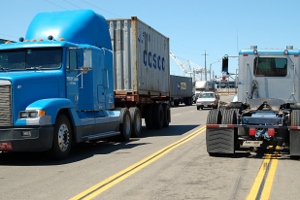PM 2.5 refers to the smallest soot particles that air officials measure – each particle is about 1/70th the width of a human hair. These particles are so small, they’re invisible to the naked eye. They’re small enough to travel deep into the delicate alveoli, or air sacs, in our lungs, where they can cause or exacerbate asthma and other breathing problems. From there, they can make their way into our bloodstream, leading to heart attacks and strokes. The particulate from diesel trucks, which contains a number of carcinogenic compounds, can also cause lung cancer. (Check out this excellent Q&A on the hazards of diesel soot.)
The black numbers describe the current level. Blue and red figures describe the change from that same hour, the day before.
When you look at the chart, check out the PM numbers for West Oakland, right next to the Port of Oakland. These are what air officials point to when asked to justify the new rules for Port truckers, which this story, and this one, describe. A few years ago, the BAAQMD conducted a detailed health assessment of West Oakland residents, finding cancer rates three times the Bay Area average. In this week’s radio story, we also cite a 2008 Harvard study on lung cancer rates in truckers. Here’s a story about the study, and the study itself.
Poke around the QUEST website a bit and you’ll find an abundance of media on this subject. Start with Gabriela Quiros’s terrific TV story, “Perilous Diesel.” Gabi’s also taken a closer look at some of the mysteries surrounding childhood asthma in another TV piece, “Asthma: What Brought on the Epidemic?”
Last but not least, here’s a slide show of scenes from this week’s radio QUEST story, featuring characters and scenes from several sides of the campaign to reduce diesel soot.
37.7955333 -122.2846028
 The particulate from diesel trucks, which contains a number of carcinogenic compounds, can also cause lung cancer.
The particulate from diesel trucks, which contains a number of carcinogenic compounds, can also cause lung cancer.